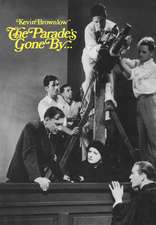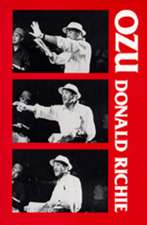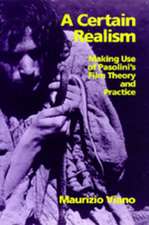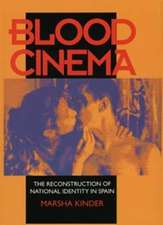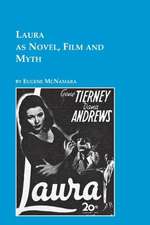Popular Music and the Moving Image in Eastern Europe
Editat de Professor Ewa Mazierska, Professor Zsolt Gyorien Limba Engleză Hardback – 12 dec 2018
| Toate formatele și edițiile | Preț | Express |
|---|---|---|
| Paperback (1) | 169.28 lei 3-5 săpt. | +20.59 lei 7-13 zile |
| Bloomsbury Publishing – 24 iun 2020 | 169.28 lei 3-5 săpt. | +20.59 lei 7-13 zile |
| Hardback (1) | 716.15 lei 6-8 săpt. | |
| Bloomsbury Publishing – 12 dec 2018 | 716.15 lei 6-8 săpt. |
Preț: 716.15 lei
Preț vechi: 1028.61 lei
-30% Nou
137.04€ • 142.15$ • 114.27£
Carte tipărită la comandă
Livrare economică 27 martie-10 aprilie
Specificații
ISBN-10: 1501337173
Pagini: 256
Ilustrații: 1 bw illus
Dimensiuni: 152 x 229 x 16 mm
Greutate: 0.57 kg
Editura: Bloomsbury Publishing
Colecția Bloomsbury Academic
Locul publicării:New York, United States
Caracteristici
Notă biografică
Ewa Mazierska is Professor of Film Studies at the University of Central Lancashire, UK. She has published over twenty monographs and edited collections on film and popular music, including Popular Music in Eastern Europe: Breaking the Cold War Paradigm (2016), Relocating Popular Music (2015), co-edited with Georgina Gregory, From Self- Fulfillment to Survival of the Fittest: Work in European Cinema from the 1960s to the Present (2015), and European Cinema and Intertextuality: History, Memory, Politics (2011). Mazierska is the principal editor of the Studies in Eastern European Cinema journal.Zsolt Gyori is an Assistant Professor in the Department of British Studies at the University of Debrecen, Hungary. He has edited collections of essays in Hungarian on British cinema, on body, subjectivity, race and gender in post-communist Hungarian cinema and the connective structures of space, power and identity in Hungarian cinema. He is also the author of Films, Auteurs, Critical-Clinical Readings (2014).
Cuprins
Table of Contents Introductions: Popular Music and the Moving Image in Eastern Europe Ewa Mazierska (University of Central Lancashire, UK) and Zsolt Gyori (University of Debrecen, Hungary) Chapter 1 1968 Leftist Utopianism in The Young Girls of Rochefort and Hot SummerEvan Torner (University of Cincinnati, USA) Chapter 2 Representing Modern Romania in the Musical of State Socialist Period Gabriela Filippi (I.L. Caragiale National University of Theatre and Film, Romania) Chapter 3 Worlds That Never Were: Contemporary Eastern European Musical Comedies and the Memory of Socialism Balázs Varga (Eötvös Loránd University, Hungary) Chapter 4 Pop Music, Nostalgia and Melancholia in Dollybirds and Liza, the Fox Fairy Hajnal Király (Insitute for Hungarian Literary and Cultural Studies, Eötvös Lóránd University, Hungary) Chapter 5 When the Golden Kids Met the Bright Young Men and Women: Rebellion, Innovation and Cultural Tradition in the Czech 1960s Music Film Jonathan Owen (Courtauld Institute of Art, UK) Chapter 6 'Music Isn't Music, Words Aren't Words': Underground Music in the Hungarian Cinema of the New Sensibility Zsolt Gyori Chapter 7 Socialist Night Fever: Yugoslav Disco on Film and Television Marko Zubak (Croatian Institute of History, Croatia) Chapter 8 Disco Polo and Techno according to Maria Zmarz-Koczanowicz Ewa Mazierska Chapter 9 Musical Variations in Karpo Godina's Alternative Cinema Andrej Sprah (Slovenian Cinematheque, Slovenia) Chapter 10 Polish Music Videos: Between Parochialism and Universalism Ewa Mazierska Chapter 11 'She Stole It from Beyoncé!' - Transnational Borrowing in Bulgarian Pop-Folk Music Videos and Audience Reaction to the Practice Maya Nedyalkova (Oxford Brookes University, UK) Chapter 12 Postsocialist Social Reality in Hungarian Rap Music Videos Anna Batori (Babes-Bolyai University, Cluj-Napoca, Romania)List of ContributorsIndex
Recenzii
Popular Music and the Moving Image in Eastern Europe offers a refreshing and original contribution to the research on the region's cultural production. The authors vigorously demonstrate the paramount importance of the interface between cinema and popular music in negotiating hegemonic cultures and ideologies.
The volume offers valuable insight into the intersections of film and popular music in Eastern Europe through a set of intriguing case studies from Hungary, Poland, Czechoslovakia and the Czech Republic, Romania, Bulgaria, and Yugoslavia, spanning an extensive time period, although primarily focusing on the socialist era and its nostalgic evocations through music and film in postsocialism. Ranging from musical films - a strong focus of the book - to contemporary (Hungarian) rap or (Bulgarian) folk pop music videos, the contributions enable comparisons with regard to the musical and cinematic construction of past and present, localities and identities across genres and among different national environments within Eastern Europe. The chapters also offer unique explorations of the construction and representation of the East-West relationship as lived socially and culturally.
Descriere
Popular Music and the Moving Image in Eastern Europe is the first collection to discuss the ways in which popular music has been used cinematically, from musicals to music videos to documentary film, in Eastern Europe from 1945 to the present day. It argues that during the period of state socialism, moving image was an important tool of promoting music in the respective countries and creating popular cinema. Yet despite this importance, filmmakers who specialized in musicals lacked the social prestige of leading 'auteurs' and received little critical attention. The resulting scholarly prejudice towards pop culture created a severe shortage of critical studies of the genre.With the fall of state socialism - and with it, the need for economically viable film and media industries - brought about an unprecedented upsurge of films utilizing popular music, and a greater recognition of popular cinema as a legitimate object of study. Popular Music and the Moving Image in Eastern Europe fills the gap and demonstrates why the popular music-cinema interface needs to be theorized with respect to the political, ideological, and social forces invested in popular culture.



